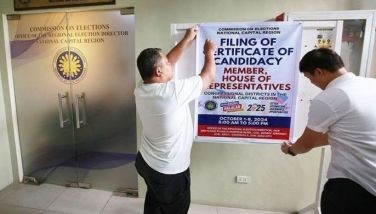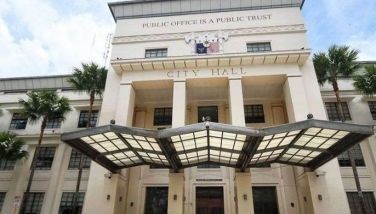GSIS to expand GW@PS services abroad
December 21, 2006 | 12:00am
The Government Service Insurance System is looking at expanding its GSIS Wireless Automated Processing System (G-W@PS) service abroad, especially in key cities in the United States where many GSIS pensioners reside.
GSIS President and General Manager Winston Garcia said that this month, the GSIS will start putting up G-W@PS kiosk overseas, beginning at the Philippine consular office in Los Angeles, California.
"We will be launching the system in the consular office in Los Angeles, California and we'll also be putting up one kiosk in San Francisco, New York, Hawaii, Canada, and Australia where our pensioners are known to congregate," he said.
The GSIS chief noted that the presence of the G-W@PS service abroad would alleviate the need for old-age pensioners who have migrated abroad to come back to the Philippines just to prove that they are still alive and therefore eligible to receive their pension.
Under the rules set by the GSIS, old-age pensioners who have migrated abroad are required to report to the GSIS on their birth month every year as proof of their existence, otherwise their pensions will be suspended.
"With their advanced age, it's very inconvenient for them to do this. That's why putting the kiosks overseas will make it easier for them to confirm their yearly reporting," Garcia said.
Garcia also said the biometrics confirmation feature of the G-W@PS provides a more accurate means of verification for the GSIS.
Likewise, pensioners abroad can withdraw their pensions in the currency of the country they are in even as the pensions were deposited in pesos.
The G-W@PS kiosk is a 55-inch high, ATM-like machine, with a 28-inch by 16-inch touch screen monitor. It can identify a GSIS member, display all of the member's records, and even process loan applications of members without any documentary requirement.
It combines some of the most advanced technologies in the world such as radio frequency identification (RFID), biometrics, general packet radio service (GPRS), short message service (SMS), and virtual private network (VPN), among others.
The G-W@PS replicates the whole process a member goes through with the GSIS, such as applying for a loan. To transact, the member only needs to go to a G-W@PS kiosk and place his eCard Plus in front of the radio frequency card reader for it to recognize him as a GSIS member. The eCard Plus is embedded with a RFID microchip which the kiosk can recognize.
The member applies for a loan following the instructions displayed on the touch screen monitor until the G-W@PS shows a tentative computation of the member's loan application. The member is then asked to have his fingerprint scanned before his application is processed. This biometrics system replaces the need for signatures.
In mere seconds, the G-W@PS summarizes the loan applications and sends it to the government agency where the member is employed. In a separate computer terminal, the agency's authorized officer either approves or disapproves the loan applications.
Via Web, the authorized officer sends back the validated loan applications to the G-W@PS, which consequently processes approved loan applications. G-W@PS sends an electronic advisory to Union Bank to deposit the loan proceeds in the member's eCard Plus' ATM bank account.
The member then receives a text message that the money is already in his account, ready to be withdrawn in any of the 6,000 ATMs nationwide. - Jasmin R. Uy
GSIS President and General Manager Winston Garcia said that this month, the GSIS will start putting up G-W@PS kiosk overseas, beginning at the Philippine consular office in Los Angeles, California.
"We will be launching the system in the consular office in Los Angeles, California and we'll also be putting up one kiosk in San Francisco, New York, Hawaii, Canada, and Australia where our pensioners are known to congregate," he said.
The GSIS chief noted that the presence of the G-W@PS service abroad would alleviate the need for old-age pensioners who have migrated abroad to come back to the Philippines just to prove that they are still alive and therefore eligible to receive their pension.
Under the rules set by the GSIS, old-age pensioners who have migrated abroad are required to report to the GSIS on their birth month every year as proof of their existence, otherwise their pensions will be suspended.
"With their advanced age, it's very inconvenient for them to do this. That's why putting the kiosks overseas will make it easier for them to confirm their yearly reporting," Garcia said.
Garcia also said the biometrics confirmation feature of the G-W@PS provides a more accurate means of verification for the GSIS.
Likewise, pensioners abroad can withdraw their pensions in the currency of the country they are in even as the pensions were deposited in pesos.
The G-W@PS kiosk is a 55-inch high, ATM-like machine, with a 28-inch by 16-inch touch screen monitor. It can identify a GSIS member, display all of the member's records, and even process loan applications of members without any documentary requirement.
It combines some of the most advanced technologies in the world such as radio frequency identification (RFID), biometrics, general packet radio service (GPRS), short message service (SMS), and virtual private network (VPN), among others.
The G-W@PS replicates the whole process a member goes through with the GSIS, such as applying for a loan. To transact, the member only needs to go to a G-W@PS kiosk and place his eCard Plus in front of the radio frequency card reader for it to recognize him as a GSIS member. The eCard Plus is embedded with a RFID microchip which the kiosk can recognize.
The member applies for a loan following the instructions displayed on the touch screen monitor until the G-W@PS shows a tentative computation of the member's loan application. The member is then asked to have his fingerprint scanned before his application is processed. This biometrics system replaces the need for signatures.
In mere seconds, the G-W@PS summarizes the loan applications and sends it to the government agency where the member is employed. In a separate computer terminal, the agency's authorized officer either approves or disapproves the loan applications.
Via Web, the authorized officer sends back the validated loan applications to the G-W@PS, which consequently processes approved loan applications. G-W@PS sends an electronic advisory to Union Bank to deposit the loan proceeds in the member's eCard Plus' ATM bank account.
The member then receives a text message that the money is already in his account, ready to be withdrawn in any of the 6,000 ATMs nationwide. - Jasmin R. Uy
BrandSpace Articles
<
>
- Latest
- Trending
Trending
Latest
Trending
Latest
Recommended






















